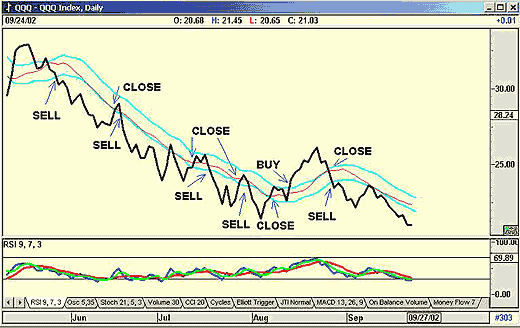
HOT TOPICS LIST
- MACD
- Fibonacci
- RSI
- Gann
- ADXR
- Stochastics
- Volume
- Triangles
- Futures
- Cycles
- Volatility
- ZIGZAG
- MESA
- Retracement
- Aroon
INDICATORS LIST
LIST OF TOPICS
PRINT THIS ARTICLE
by Koos van der Merwe
QQQs are representative of the Nasdaq index, and are presently in a short position. Here is why.
Position: Sell
Koos van der Merwe
Has been a technical analyst since 1969, and has worked as a futures and options trader with First Financial Futures in Johannesburg, South Africa.
PRINT THIS ARTICLE
MOVING AVERAGES
Technical Simplicity
09/26/02 03:40:56 PMby Koos van der Merwe
QQQs are representative of the Nasdaq index, and are presently in a short position. Here is why.
Position: Sell
| In all the years I have been a technical analyst, studying the theories of Ralph Elliott and W.D.Gann, I keep coming back to the KISS principle as the best form of analysis. To this end I would like to reintroduce technicians to moving averages, but this time used with a difference not usually published. I call the first strategy the JM strategy and it has proved successful for conservative investors. |
| Every technician knows that a moving average band traces the highs and lows of a stock. How many technicians however, have applied that band within a trading range? Looking at the chart below, you will see what I mean. |

|
| Figure 1: QQQ with moving average bands. |
| Graphic provided by: AdvancedGET. |
| |
| The chart is of the QQQs. I have drawn three moving averages. The light blue line is a moving average band set to 15-days and offset, in this case by 3% upwards and -3% downwards. These are the long/short parameters. With this setup, when the price breaks above the upper band, I will go long, and when it breaks below the lower band, I will go short (indicated by sell on the chart). The RSI indicator acts as a decision helper, so should the indicator trend be moving downwards, I feel a great deal more comfortable in my decision. |
| To close my position, I will use an optimized moving average, which is usually short-term. It is the red line on the chart. A break below or above this moving average will close a position. |
| As you can see, at the moment I will be short the QQQs either by selling them short in the market, or by buying a PUT option. I will hold my short position until the QQQ breaks above the red moving average or breaks above a following stop-loss, whichever is sooner. Admittedly I am always late in entering the market, but at least I am always in the right direction. The strategy allows profits to run and kills losses quickly. Do experiment with the closing moving average to suit your personality. I have often ignored it, using the upper band or a stop-loss as my closing strategy. |
Has been a technical analyst since 1969, and has worked as a futures and options trader with First Financial Futures in Johannesburg, South Africa.
| Address: | 3256 West 24th Ave |
| Vancouver, BC | |
| Phone # for sales: | 6042634214 |
| E-mail address: | petroosp@gmail.com |
Click here for more information about our publications!
Comments
Date: 09/29/02Rank: 2Comment: This is thought provoking but exasperating. Are these articles only for those who have studied Technicals as long as the writer has?
If these articles are to be of use for relative newcomers to Technical Analysis, it would be appreciated if the authors would be more specific and detailed in their explanation of the reason for their assumptions. I have tried to duplicate the above chart but cannot do so... e.g. 3% of what? And in this example what EMA is considered an optimal?
Thank you,
B. H. Peterson
Date: 09/29/02Rank: 5Comment:
Date: 10/01/02Rank: 4Comment:
Date: 10/01/02Rank: 5Comment:
Date: 10/01/02Rank: 5Comment:
Date: 10/02/02Rank: 4Comment:

|

Request Information From Our Sponsors
- StockCharts.com, Inc.
- Candle Patterns
- Candlestick Charting Explained
- Intermarket Technical Analysis
- John Murphy on Chart Analysis
- John Murphy's Chart Pattern Recognition
- John Murphy's Market Message
- MurphyExplainsMarketAnalysis-Intermarket Analysis
- MurphyExplainsMarketAnalysis-Visual Analysis
- StockCharts.com
- Technical Analysis of the Financial Markets
- The Visual Investor
- VectorVest, Inc.
- Executive Premier Workshop
- One-Day Options Course
- OptionsPro
- Retirement Income Workshop
- Sure-Fire Trading Systems (VectorVest, Inc.)
- Trading as a Business Workshop
- VectorVest 7 EOD
- VectorVest 7 RealTime/IntraDay
- VectorVest AutoTester
- VectorVest Educational Services
- VectorVest OnLine
- VectorVest Options Analyzer
- VectorVest ProGraphics v6.0
- VectorVest ProTrader 7
- VectorVest RealTime Derby Tool
- VectorVest Simulator
- VectorVest Variator
- VectorVest Watchdog
